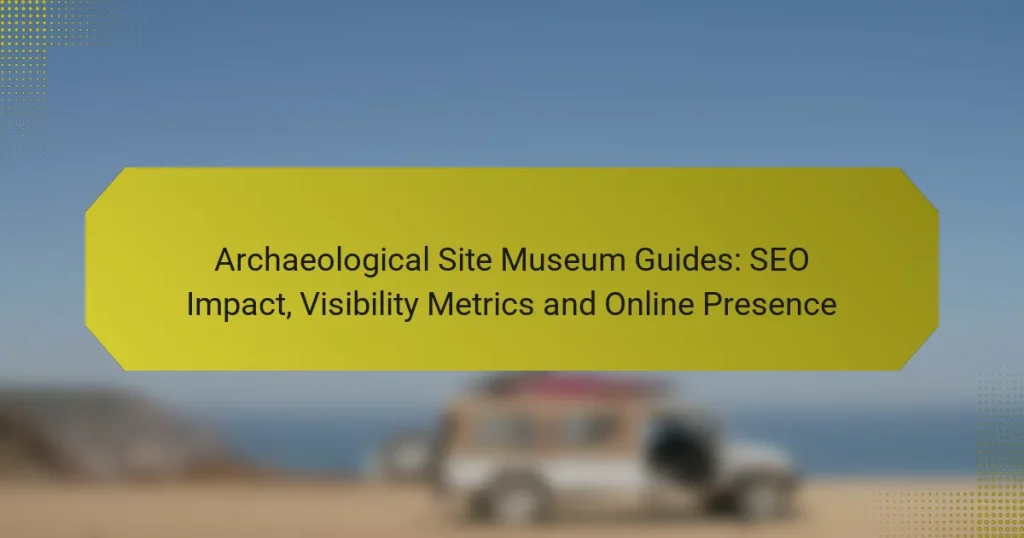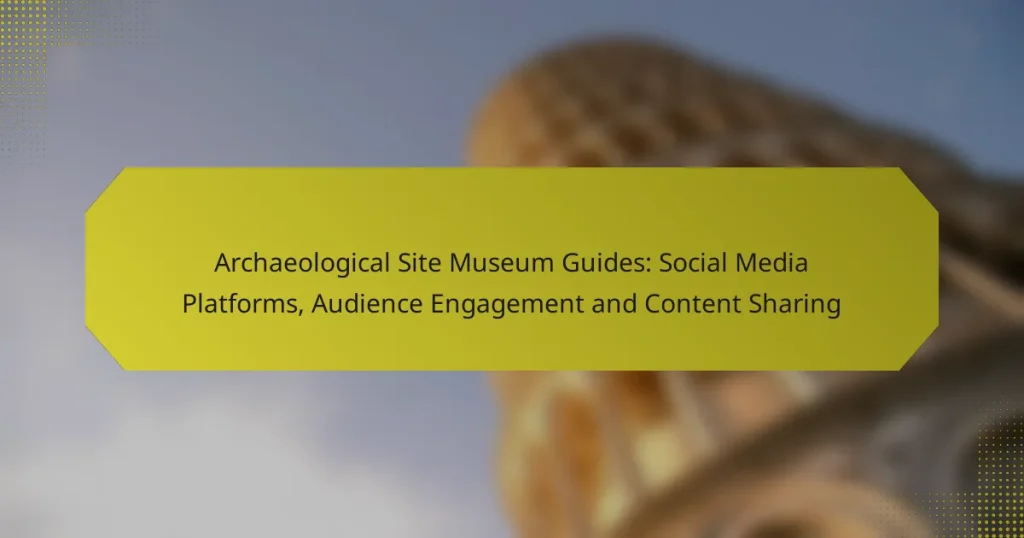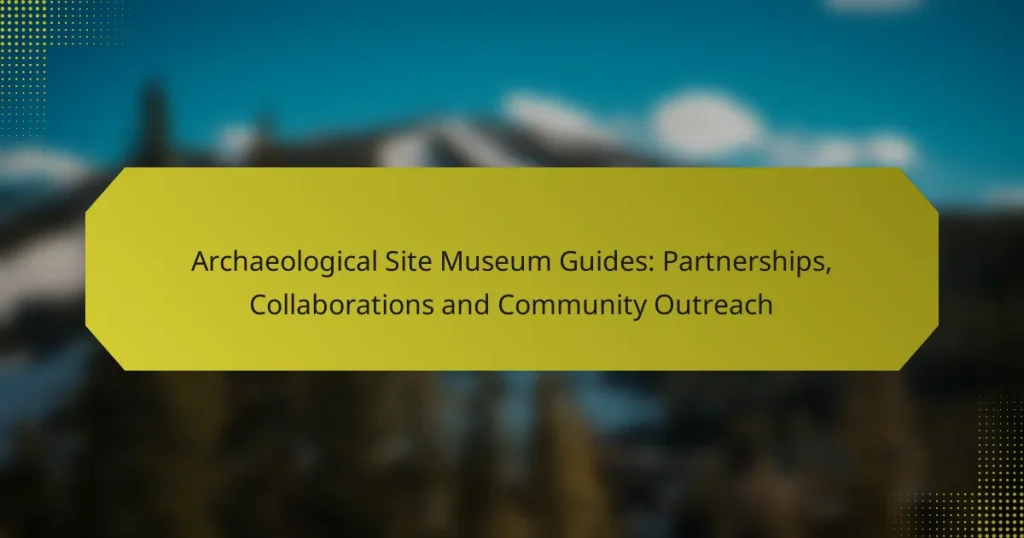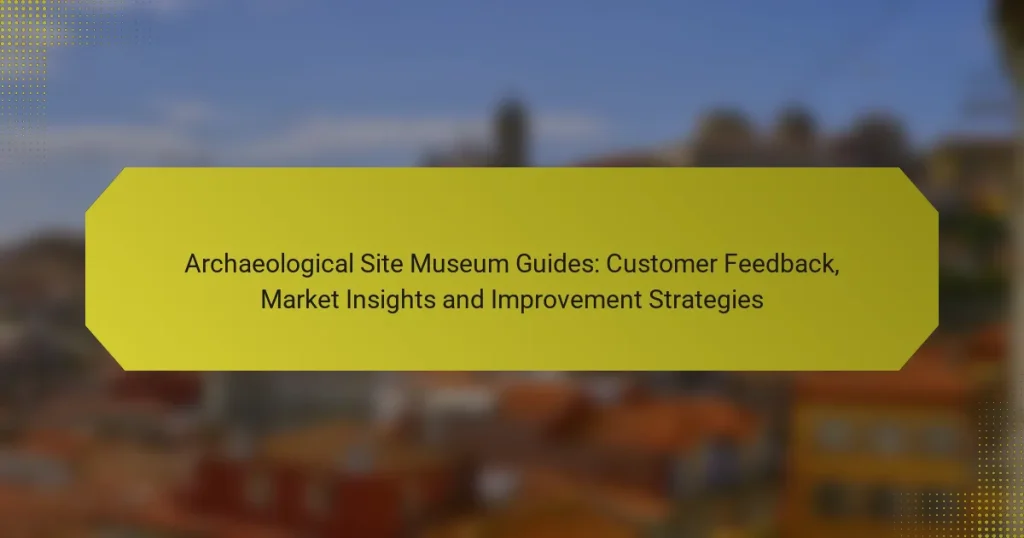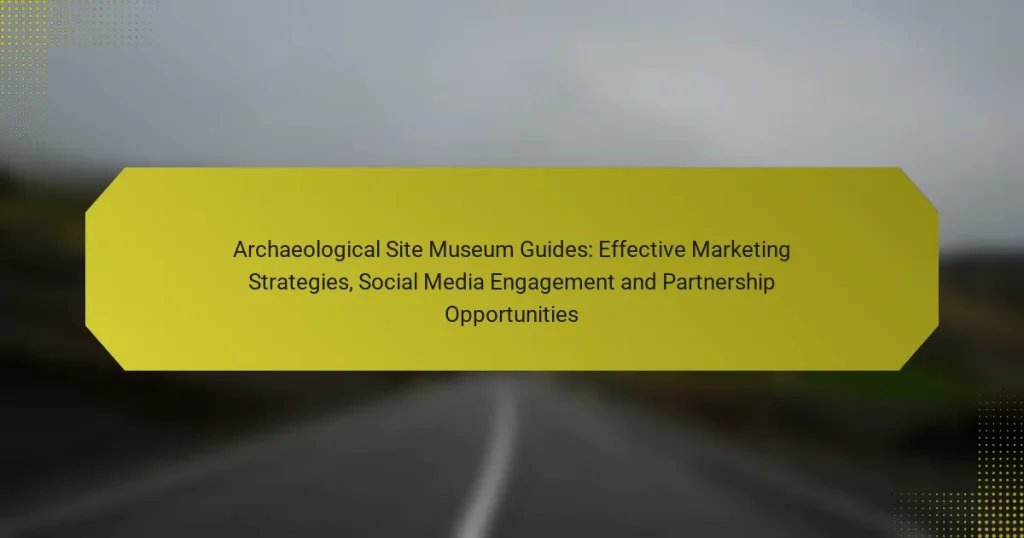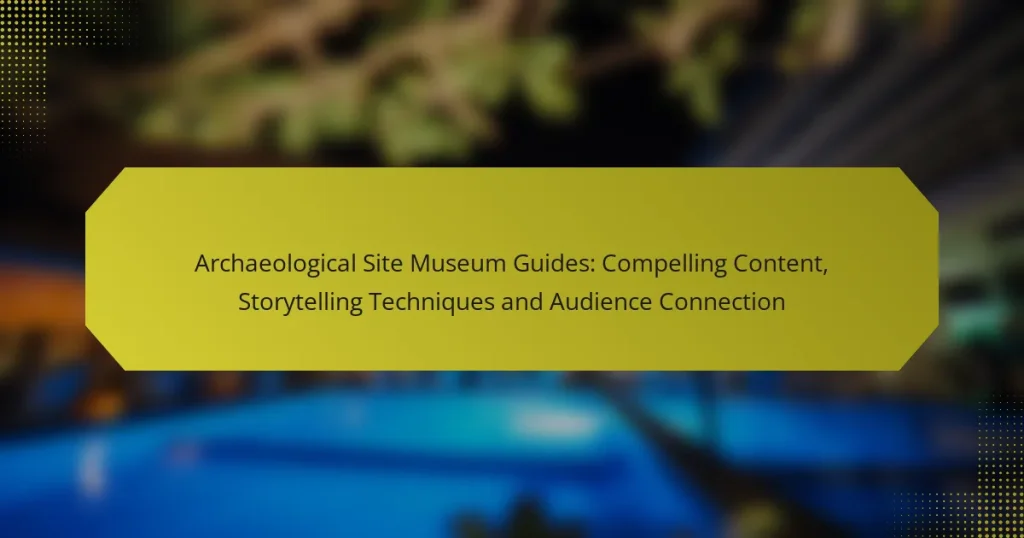Effective marketing strategies for museum guides are essential for attracting visitors and enhancing their overall experience. By utilizing channels such as social media, email newsletters, and virtual tours, museums can increase visibility and foster engagement with diverse audiences. These strategies not only promote events and exhibitions but also create memorable connections that encourage repeat visits.
Archaeological Site Museum Guides: Social Media Platforms, Audience Engagement and Content Sharing
Archaeological Site Museum Guides: Partnerships, Collaborations and Community Outreach
Archaeological Site Museum Guides: Customer Feedback, Market Insights and Improvement Strategies
Archaeological Site Museum Guides: Effective Marketing Strategies, Social Media Engagement and Partnership Opportunities
Archaeological Site Museum Guides: Compelling Content, Storytelling Techniques and Audience Connection
What are effective marketing strategies for museum guides?
Effective marketing strategies for museum guides focus on engaging potential visitors through various channels, enhancing visibility, and creating memorable experiences. By leveraging content marketing, social media, email newsletters, local collaborations, and virtual tours, museums can attract a wider audience and increase attendance.
Content marketing through blogs
Content marketing through blogs allows museum guides to share insights, stories, and educational material related to exhibits. By creating engaging blog posts, museums can position themselves as thought leaders in the cultural sector and draw in visitors interested in specific topics.
Consider writing posts that highlight upcoming exhibitions, behind-the-scenes looks at collections, or interviews with curators. Regular updates can keep the audience engaged and encourage repeat visits.
Social media engagement
Social media engagement is crucial for reaching a broader audience and fostering community interaction. Museums should utilize platforms like Instagram, Facebook, and Twitter to share captivating images, event announcements, and interactive content.
Engage followers by hosting live Q&A sessions, sharing user-generated content, or running contests that encourage visitors to share their experiences. This not only boosts visibility but also builds a loyal online community.
Email newsletters
Email newsletters are an effective way to keep potential visitors informed about upcoming events, exhibitions, and special offers. By collecting email addresses through website sign-ups or in-person visits, museums can create targeted campaigns that resonate with their audience.
Ensure newsletters are visually appealing and concise, highlighting key information and including clear calls to action. Regular communication can help maintain interest and encourage attendance at events.
Collaborations with local businesses
Collaborating with local businesses can enhance marketing efforts and create mutually beneficial partnerships. Museums can partner with restaurants, hotels, or shops to offer joint promotions or discounts, attracting visitors to both venues.
Consider organizing events that feature local artists or businesses, which can draw their customer base into the museum. This strategy not only increases foot traffic but also strengthens community ties.
Virtual tours and online experiences
Virtual tours and online experiences provide an innovative way to engage audiences who may not be able to visit in person. By offering immersive online content, museums can reach a global audience and provide educational resources to schools and individuals.
Utilize platforms that allow for interactive experiences, such as 360-degree tours or live-streamed events. This approach can attract new visitors and create additional revenue streams through online ticket sales or memberships.
How can museums leverage social media for marketing?
Museums can effectively use social media to enhance their marketing efforts by engaging audiences, promoting events, and sharing their collections. By creating visually appealing content and fostering community interaction, museums can attract more visitors and build a loyal following.
Instagram for visual storytelling
Instagram is a powerful platform for museums to showcase their exhibits and collections through captivating images and videos. By posting high-quality visuals, museums can tell stories that resonate with their audience, drawing attention to unique artifacts and exhibitions.
Utilizing features like Instagram Stories and Reels allows museums to share behind-the-scenes content, artist interviews, or live tours, creating a more immersive experience. Regularly engaging with followers through comments and direct messages can also enhance community connections.
Facebook events and community building
Facebook is ideal for promoting museum events and fostering a sense of community. Museums can create event pages for exhibitions, workshops, or lectures, allowing users to RSVP and share with friends, which increases visibility.
Additionally, engaging with local community groups on Facebook can help museums reach a broader audience. Posting updates, sharing user-generated content, and responding to inquiries can strengthen relationships with visitors and encourage repeat attendance.
Twitter for real-time updates
Twitter is effective for sharing real-time updates and engaging in conversations with followers. Museums can use Twitter to announce last-minute changes, special promotions, or live event coverage, keeping their audience informed and engaged.
Using relevant hashtags can help museums reach new audiences and join broader conversations. Regularly tweeting interesting facts or trivia about exhibits can also spark interest and encourage visits.
What are the best practices for email marketing in museums?
The best practices for email marketing in museums involve creating targeted campaigns that resonate with specific audience segments. By utilizing personalized content and providing regular updates on exhibitions, museums can enhance engagement and foster a loyal visitor base.
Segmenting audience for targeted campaigns
Segmenting your audience allows museums to tailor their email marketing efforts to different groups based on interests, demographics, or past behaviors. For instance, families may appreciate information about kid-friendly exhibits, while art enthusiasts might prefer details on upcoming gallery openings.
Consider using data from past visits or surveys to create segments. This approach can increase open rates and engagement, as recipients receive content that is relevant to their specific interests.
Personalized content and offers
Personalized content in email marketing can significantly boost engagement. This includes addressing recipients by name and offering tailored recommendations based on their previous visits or expressed interests.
For example, if a visitor attended a photography exhibit, sending them an email about a related workshop or a new photography exhibit can enhance their experience and encourage repeat visits. Special offers, such as discounts on memberships or exclusive previews, can also be effective.
Regular updates on exhibitions
Keeping your audience informed about upcoming exhibitions is crucial for maintaining interest. Regular updates can include sneak peeks, behind-the-scenes content, or interviews with curators, which can create excitement and anticipation.
Consider sending a monthly newsletter that highlights new exhibitions, events, and educational programs. This not only keeps your audience engaged but also positions your museum as a dynamic and evolving space worth visiting frequently.
How can museums measure the success of their marketing strategies?
Museums can measure the success of their marketing strategies through various metrics that reflect audience engagement and outreach effectiveness. Key indicators include website traffic, social media interactions, and email performance, which provide insights into visitor interest and campaign impact.
Website traffic analytics
Website traffic analytics involve tracking the number of visitors to a museum’s website and their behavior on the site. Tools like Google Analytics can help museums understand which pages attract the most visitors, how long they stay, and where they come from. Analyzing these metrics can reveal the effectiveness of online marketing campaigns.
For example, a museum may notice a spike in traffic following a specific social media post or email campaign, indicating successful outreach. Museums should aim for a consistent increase in unique visitors over time, ideally targeting a growth rate of 10-20% annually.
Social media engagement metrics
Social media engagement metrics measure how audiences interact with a museum’s content on platforms like Facebook, Instagram, and Twitter. Key metrics include likes, shares, comments, and follower growth. High engagement rates suggest that content resonates with audiences and can drive more visitors to the museum.
Museums should track engagement rates regularly, aiming for a minimum engagement rate of 1-3% on posts. They can enhance engagement by posting interactive content, such as polls or behind-the-scenes videos, which often lead to increased shares and visibility.
Email open and click rates
Email open and click rates are crucial for assessing the effectiveness of email marketing campaigns. The open rate indicates how many recipients opened the email, while the click rate shows how many clicked on links within the email. Museums should strive for an open rate of 20-30% and a click rate of 2-5% as benchmarks for success.
To improve these rates, museums can segment their email lists based on visitor interests and tailor content accordingly. Personalizing subject lines and including clear calls to action can also significantly boost engagement and drive traffic to the museum’s website or events.
What are the prerequisites for creating a successful marketing plan?
Creating a successful marketing plan for museum guides requires a clear understanding of your target audience and the unique offerings of your museum. Key prerequisites include market research, setting specific goals, and identifying the resources available for implementation.
Understanding your target audience
Identifying your target audience is crucial for effective marketing. Consider demographics such as age, interests, and cultural backgrounds to tailor your messaging. For example, family-oriented programs may attract parents with children, while art enthusiasts might respond better to specialized tours.
Conducting market research
Market research helps you understand the competitive landscape and visitor preferences. Use surveys, focus groups, or social media analytics to gather insights. This data can inform your marketing strategies and help you identify gaps in the market that your museum can fill.
Setting clear objectives
Establishing clear, measurable objectives is essential for tracking the success of your marketing efforts. Goals might include increasing visitor numbers by a certain percentage or boosting engagement on social media platforms. Ensure that these objectives align with your museum’s overall mission and vision.
Identifying available resources
Assessing your available resources, including budget, staff, and technology, is critical for executing your marketing plan. Determine how much you can allocate to advertising, promotional materials, and events. Consider leveraging partnerships with local businesses or organizations to maximize your reach without overspending.
